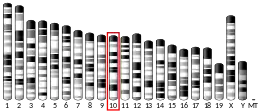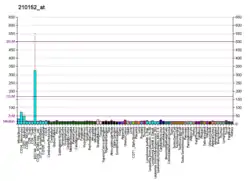Leukocyte immunoglobulin-like receptor subfamily B member 4 is a protein that in humans is encoded by the LILRB4 gene.[5][6][7]
This gene is a member of the leukocyte immunoglobulin-like receptor (LIR) family, which is found in a gene cluster at chromosomal region 19q13.4. The encoded protein belongs to the subfamily B class of LIR receptors which contain two or four extracellular immunoglobulin domains, a transmembrane domain, and two to four cytoplasmic immunoreceptor tyrosine-based inhibitory motifs (ITIMs). The receptor is expressed on monocytic cells and transduces a negative signal that inhibits stimulation of an immune response. The receptor can also function in antigen capture and presentation. It is thought to control inflammatory responses and cytotoxicity to help focus the immune response and limit autoreactivity. LILRB4 has also been proposed to be a potential target for tumor immunotherapy. It has been shown to express on tumor-associated macrophages and negatively regulate immune response in tumor.[8] The expression of LILRB4 on monocytic myeloid leukemia cells supports infiltration and inhibits T cell proliferation. Multiple transcript variants encoding different isoforms have been found for this gene.[7]
Interactions
LILRB4 has been shown to interact with PTPN6[9] and INPP5D (SHIP-1).[10]
See also
References
- 1 2 3 ENSG00000186818, ENSG00000276042, ENSG00000278279, ENSG00000278555 GRCh38: Ensembl release 89: ENSG00000275730, ENSG00000186818, ENSG00000276042, ENSG00000278279, ENSG00000278555 - Ensembl, May 2017
- 1 2 3 GRCm38: Ensembl release 89: ENSMUSG00000112023 - Ensembl, May 2017
- ↑ "Human PubMed Reference:". National Center for Biotechnology Information, U.S. National Library of Medicine.
- ↑ "Mouse PubMed Reference:". National Center for Biotechnology Information, U.S. National Library of Medicine.
- ↑ Cella M, Döhring C, Samaridis J, Dessing M, Brockhaus M, Lanzavecchia A, Colonna M (May 1997). "A novel inhibitory receptor (ILT3) expressed on monocytes, macrophages, and dendritic cells involved in antigen processing". The Journal of Experimental Medicine. 185 (10): 1743–51. doi:10.1084/jem.185.10.1743. PMC 2196312. PMID 9151699.
- ↑ Samaridis J, Colonna M (March 1997). "Cloning of novel immunoglobulin superfamily receptors expressed on human myeloid and lymphoid cells: structural evidence for new stimulatory and inhibitory pathways". European Journal of Immunology. 27 (3): 660–5. doi:10.1002/eji.1830270313. PMID 9079806. S2CID 2212182.
- 1 2 "Entrez Gene: LILRB4 leukocyte immunoglobulin-like receptor, subfamily B (with TM and ITIM domains), member 4".
- ↑ Sharma N, Atolagbe OT, Ge Z, Allison JP (July 2021). "LILRB4 suppresses immunity in solid tumors and is a potential target for immunotherapy". The Journal of Experimental Medicine. 218 (7). doi:10.1084/jem.20201811. PMC 8117208. PMID 33974041.
- ↑ Wang LL, Blasioli J, Plas DR, Thomas ML, Yokoyama WM (February 1999). "Specificity of the SH2 domains of SHP-1 in the interaction with the immunoreceptor tyrosine-based inhibitory motif-bearing receptor gp49B". Journal of Immunology. 162 (3): 1318–23. doi:10.4049/jimmunol.162.3.1318. PMID 9973385.
- ↑ Zurli V, Wimmer G, Cattaneo F, Candi V, Cencini E, Gozzetti A, et al. (November 2017). "Ectopic ILT3 controls BCR-dependent activation of Akt in B-cell chronic lymphocytic leukemia". Blood. 130 (18): 2006–2017. doi:10.1182/blood-2017-03-775858. PMID 28931525.
Further reading
- Deng M, Gui X, Kim J, Xie L, Chen W, Li Z, et al. (October 2018). "LILRB4 signalling in leukaemia cells mediates T cell suppression and tumour infiltration". Nature. 562 (7728): 605–609. Bibcode:2018Natur.562..605D. doi:10.1038/s41586-018-0615-z. PMC 6296374. PMID 30333625.
- John S, Chen H, Deng M, Gui X, Wu G, Chen W, Li Z, Zhang N, An Z, Zhang CC (October 2018). "A Novel Anti-LILRB4 CAR-T Cell for the Treatment of Monocytic AML". Molecular Therapy. 26 (10): 2487–2495. doi:10.1016/j.ymthe.2018.08.001. PMC 6171100. PMID 30131301.
- Gui X, Deng M, Song H, Chen Y, Xie J, Li Z, et al. (August 2019). "Disrupting LILRB4/APOE Interaction by an Efficacious Humanized Antibody Reverses T-cell Suppression and Blocks AML Development". Cancer Immunology Research. 7 (8): 1244–1257. doi:10.1158/2326-6066.CIR-19-0036. PMC 6677629. PMID 31213474.
- Suciu-Foca N, Cortesini R (July 2007). "Central role of ILT3 in the T suppressor cell cascade". Cellular Immunology. 248 (1): 59–67. doi:10.1016/j.cellimm.2007.01.013. PMID 17923119.
- Arm JP, Nwankwo C, Austen KF (September 1997). "Molecular identification of a novel family of human Ig superfamily members that possess immunoreceptor tyrosine-based inhibition motifs and homology to the mouse gp49B1 inhibitory receptor". Journal of Immunology. 159 (5): 2342–9. doi:10.4049/jimmunol.159.5.2342. PMID 9278324.
- Kuroiwa A, Yamashita Y, Inui M, Yuasa T, Ono M, Nagabukuro A, et al. (January 1998). "Association of tyrosine phosphatases SHP-1 and SHP-2, inositol 5-phosphatase SHIP with gp49B1, and chromosomal assignment of the gene". The Journal of Biological Chemistry. 273 (2): 1070–4. doi:10.1074/jbc.273.2.1070. PMID 9422771.
- Borges L, Hsu ML, Fanger N, Kubin M, Cosman D (December 1997). "A family of human lymphoid and myeloid Ig-like receptors, some of which bind to MHC class I molecules". Journal of Immunology. 159 (11): 5192–6. doi:10.4049/jimmunol.159.11.5192. PMID 9548455.
- Torkar M, Norgate Z, Colonna M, Trowsdale J, Wilson MJ (December 1998). "Isotypic variation of novel immunoglobulin-like transcript/killer cell inhibitory receptor loci in the leukocyte receptor complex". European Journal of Immunology. 28 (12): 3959–67. doi:10.1002/(SICI)1521-4141(199812)28:12<3959::AID-IMMU3959>3.0.CO;2-2. PMID 9862332.
- Wang LL, Blasioli J, Plas DR, Thomas ML, Yokoyama WM (February 1999). "Specificity of the SH2 domains of SHP-1 in the interaction with the immunoreceptor tyrosine-based inhibitory motif-bearing receptor gp49B". Journal of Immunology. 162 (3): 1318–23. doi:10.4049/jimmunol.162.3.1318. PMID 9973385.
- Wilson MJ, Torkar M, Haude A, Milne S, Jones T, Sheer D, et al. (April 2000). "Plasticity in the organization and sequences of human KIR/ILT gene families". Proceedings of the National Academy of Sciences of the United States of America. 97 (9): 4778–83. Bibcode:2000PNAS...97.4778W. doi:10.1073/pnas.080588597. PMC 18309. PMID 10781084.
- Heinzmann A, Blattmann S, Forster J, Kuehr J, Deichmann KA (June 2000). "Common polymorphisms and alternative splicing in the ILT3 gene are not associated with atopy". European Journal of Immunogenetics. 27 (3): 121–7. doi:10.1046/j.1365-2370.2000.00214.x. PMID 10940079.
- Liu WR, Kim J, Nwankwo C, Ashworth LK, Arm JP (July 2000). "Genomic organization of the human leukocyte immunoglobulin-like receptors within the leukocyte receptor complex on chromosome 19q13.4". Immunogenetics. 51 (8–9): 659–69. doi:10.1007/s002510000183. PMID 10941837. S2CID 23687483.
- Young NT, Canavez F, Uhrberg M, Shum BP, Parham P (2001). "Conserved organization of the ILT/LIR gene family within the polymorphic human leukocyte receptor complex". Immunogenetics. 53 (4): 270–8. doi:10.1007/s002510100332. PMID 11491530. S2CID 2819935.
- Chang CC, Ciubotariu R, Manavalan JS, Yuan J, Colovai AI, Piazza F, et al. (March 2002). "Tolerization of dendritic cells by T(S) cells: the crucial role of inhibitory receptors ILT3 and ILT4". Nature Immunology. 3 (3): 237–43. doi:10.1038/ni760. PMID 11875462. S2CID 35400503.
- LeMaoult J, Zafaranloo K, Le Danff C, Carosella ED (April 2005). "HLA-G up-regulates ILT2, ILT3, ILT4, and KIR2DL4 in antigen presenting cells, NK cells, and T cells". FASEB Journal. 19 (6): 662–4. doi:10.1096/fj.04-1617fje. PMID 15670976. S2CID 24608530.
- Garner LI, Salim M, Mohammed F, Willcox BE (June 2006). "Expression, purification, and refolding of the myeloid inhibitory receptor leukocyte immunoglobulin-like receptor-5 for structural and ligand identification studies". Protein Expression and Purification. 47 (2): 490–7. doi:10.1016/j.pep.2005.11.020. PMID 16406677.
- Kim-Schulze S, Seki T, Vlad G, Scotto L, Fan J, Colombo PC, et al. (January 2006). "Regulation of ILT3 gene expression by processing of precursor transcripts in human endothelial cells". American Journal of Transplantation. 6 (1): 76–82. doi:10.1111/j.1600-6143.2005.01162.x. PMID 16433759. S2CID 7662795.
- Kim-Schulze S, Scotto L, Vlad G, Piazza F, Lin H, Liu Z, et al. (March 2006). "Recombinant Ig-like transcript 3-Fc modulates T cell responses via induction of Th anergy and differentiation of CD8+ T suppressor cells". Journal of Immunology. 176 (5): 2790–8. doi:10.4049/jimmunol.176.5.2790. PMID 16493035.
- Vlad G, Liu Z, Zhang QY, Cortesini R, Suciu-Foca N (December 2006). "Immunosuppressive activity of recombinant ILT3". International Immunopharmacology. 6 (13–14): 1889–94. doi:10.1016/j.intimp.2006.07.017. PMID 17161342.
External links
- LILRB4+protein,+human at the U.S. National Library of Medicine Medical Subject Headings (MeSH)
This article incorporates text from the United States National Library of Medicine, which is in the public domain.




